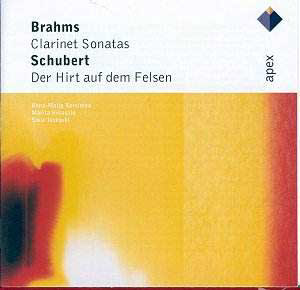Brahms was on the point of retiring from composition when the
playing of the clarinettist Richard Mühlfeld inspired him to write
these two sonatas, as well as a quintet and a trio including the clarinet,
and also to go back generally on his decision to retire.
Mindful of this, many players aim to evoke lovingly
the warmly romantic world to which Brahms clung. If this produced distressingly
heavy-handed results in the case of Ralph Manno and Alfredo Perl (Arte
Nova 74321 27767 2), the great American clarinettist Harold Wright,
partnered by Peter Serkin, left performances which combine surging romanticism
and nostalgic songfulness (Boston Records BR 1005CD). This was recommended
as a Record of the Month about a year ago and remains a touchstone of
traditional Brahms playing, in spite of a recording which does not treat
the piano so very kindly (a fact which the present very finely engineered
issue rather points up).
The booklet gives us helpful notes on the music but
not a word on the performers. Korsimaa was a "Young Artist of the
Year" in 1988 in her native Finland and can also be heard in a
work by Crusell on the BIS label. She and Viitasalo approach the music
uncluttered, as it were, by preconceptions. Their tempi are slower than
Wright’s in all movements, but in the first sonata at least they produce
an entirely valid alternative. By making the most of the dynamic contrasts
and showing plenty of rhythmic strength they give us a Brahms who, far
from reliving nostalgically his past style, is powerfully confronting
the problems of the present. It is a less "lovely" Brahms
than Wright’s (though the actual playing is beautiful) but its sinewy
purposefulness may be preferred by those who complain that this composer
always wrote like an old man.
I am a little less happy with the second sonata which
seems, by its nature, a little less suited to a similar operation. This
is autumnal music, there is no getting away from it. I also feel
there are two miscalculations over tempi. The central section of the
second movement is marked "sostenuto", but this surely does
not mean that the original "Allegro appassionato" is to be
lost sight of wholly, the tempi is broadened in relation to it,
but it is not a new tempo altogether. This was one of Manno’s and Perl’s
mistakes and Korsimaa and Viitasalo are certainly much less heavy-handed
than the Arte Nova team. Indeed, they almost convinced me, but
the section does seem a bit too long at this tempo. The other point
was right at the end. This sonata closes with a variation movement,
mostly in a slow tempo, but for the last three pages Brahms swings into
an Allegro. The second of these pages is then marked "Più
tranquillo" and here the performance drops right back to a much
slower tempo. On the last page Brahms marks no further tempo change,
but the music plainly concludes Allegro (and so it is played). This
proves, for me, that Brahms’s "Più tranquillo" means
a change in atmosphere rather than tempo – he didn’t need to write "A
tempo" on the last page because the original tempo has not been
departed from. These performers do not agree, and evidently suppose
that the "A tempo" was not written by Brahms, either because
he thought it was obvious or because he just forgot. However, listen
to the effect; does not this Allegro seem absurdly brief, bursting in
after so much slow music and then stopping again almost at once? In
comparison, Wright and Serkin seem to have it just right.
I’m sorry to have these reservations over the second
sonata because the performance still has many fine qualities and that
of the first is really worth having alongside the Wright and Serkin
one. Another reason for getting this disc is Soile Isokoski’s performance
of the Schubert. Isokoski won the first Elly Ameling competition in
1988 and has gradually built up a fine reputation in opera houses on
both sides of the Atlantic. Earlier this year she got rave reviews for
a disc of Richard Strauss orchestral lieder, including the "Four
Last Songs". Her lovely tones negotiate this by no means simple
piece with complete ease. The performance has some other points in its
favour, too. During the long first section the tempo is held absolutely
steady; very often when the piano’s triplets give way to simple quavers
a faster tempo is adopted, presumably because the singer’s phrases become
very long indeed if the tempo is left unchanged. This evidently creates
no problems for Isokoski and the increasing melancholy of the music
is hauntingly realised. The final Allegretto is also very well judged.
Christopher Howell


